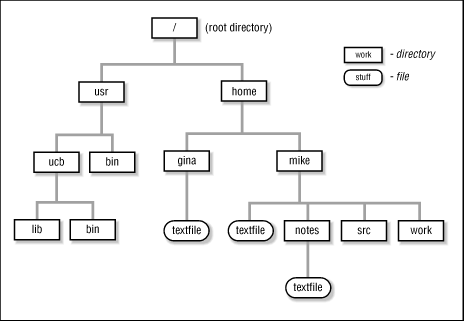1.21 Making Pathnames
Pathnames locate a file (or directory, or any other object) in the UNIX filesystem. As you read this article, refer to Figure 1.4 . It's a diagram of a (very) small part of a UNIX filesystem.
Figure 1.4: Part of a UNIX Filesystem Tree

Whenever you are using UNIX, you have a
current directory
. By
default, UNIX looks for any files or directories that you mention
within the current directory. That is, if you don't give an absolute
pathname (starting from the root,
/
), UNIX tries to look up files
relative
to the current directory. When you first log in, your
current directory is your
home directory (
1.20
)
,
which the system
administrator will assign to you. It typically has a name like
/usr/mike
or
/home/mike
. You can change your current
directory by giving the
cd
command, followed by the name of a
new directory (for example,
cd /usr/bin
). You can find out your
current directory by giving the
pwd
("print working directory") command.
If your current directory is /home/mike , and you give the command cat textfile , you are asking UNIX to locate the file textfile within the directory /home/mike . This is equivalent to the absolute path /home/mike/textfile . If you give the command cat notes/textfile , you are asking UNIX to locate the file textfile within the directory notes , within the current directory /home/mike .
A number of abbreviations help you to form relative pathnames more
conveniently. You can use the abbreviation
.
(dot) to refer to
the current working directory. You can use
..
(dot dot) to
refer to the parent of the current working directory. For example, if
your current directory is
/home/mike
,
./textfile
is the
same as
textfile
, which is the same as
/home/mike/textfile
.
The relative path
../gina/textfile
is the same as
/home/gina/textfile
;
..
moves up one level from
/home/mike
(to
/home
), and then searches for the directory
gina
and the file
textfile
.
In the C shell,
ksh
and
bash
, you can use the
abbreviation
~
(tilde) to refer
to your home directory.
~
name
refers to the home directory of the user
name
.
See article
14.11
.
Here's a summary of the rules that UNIX uses to interpret paths:
-
If the pathname begins with
/ -
If the pathname begins with
~or with~name -
The C shell, ksh and bash turn it into an absolute pathname starting at your home directory (
~), or at the home directory of the user name (~name). -
If the pathname does not begin with a
/ -
The pathname is relative to the current directory. Two relative special cases use entries that are in every UNIX directory:
Article
18.2
explains where
.
and
..
come from.
NOTE: The
.and..may appear at any point within a path. They mean "the current directory at this point in the path" and "the parent of the current directory at this point in the path." You commonly see paths starting with../../(or more) to refer to the grandparent or great-grandparent of the current directory. However, they can appear at other places in a pathname as well. For example, /usr/ucb/./bin is the same as /usr/ucb/bin ; and /usr/ucb/bin/../lib is the same as /usr/ucb/lib . Placing.or..in the middle of a path may be helpful in building paths within shell scripts, but I have never seen them used in any other useful way.
- ,





